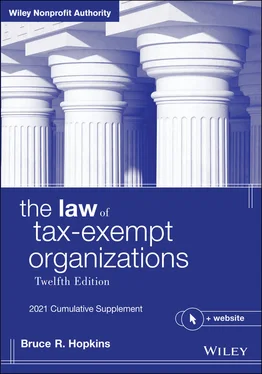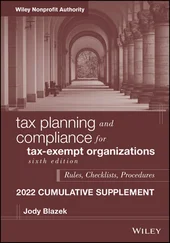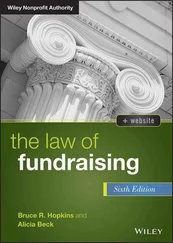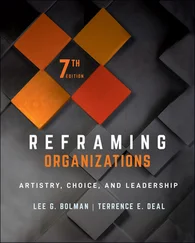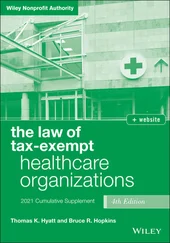Bruce R. Hopkins - The Law of Tax-Exempt Organizations, 2021 Cumulative Supplement
Здесь есть возможность читать онлайн «Bruce R. Hopkins - The Law of Tax-Exempt Organizations, 2021 Cumulative Supplement» — ознакомительный отрывок электронной книги совершенно бесплатно, а после прочтения отрывка купить полную версию. В некоторых случаях можно слушать аудио, скачать через торрент в формате fb2 и присутствует краткое содержание. Жанр: unrecognised, на английском языке. Описание произведения, (предисловие) а так же отзывы посетителей доступны на портале библиотеки ЛибКат.
- Название:The Law of Tax-Exempt Organizations, 2021 Cumulative Supplement
- Автор:
- Жанр:
- Год:неизвестен
- ISBN:нет данных
- Рейтинг книги:5 / 5. Голосов: 1
-
Избранное:Добавить в избранное
- Отзывы:
-
Ваша оценка:
- 100
- 1
- 2
- 3
- 4
- 5
The Law of Tax-Exempt Organizations, 2021 Cumulative Supplement: краткое содержание, описание и аннотация
Предлагаем к чтению аннотацию, описание, краткое содержание или предисловие (зависит от того, что написал сам автор книги «The Law of Tax-Exempt Organizations, 2021 Cumulative Supplement»). Если вы не нашли необходимую информацию о книге — напишите в комментариях, мы постараемся отыскать её.
The Law of Tax-Exempt Organizations, 2021 Cumulative Supplement — читать онлайн ознакомительный отрывок
Ниже представлен текст книги, разбитый по страницам. Система сохранения места последней прочитанной страницы, позволяет с удобством читать онлайн бесплатно книгу «The Law of Tax-Exempt Organizations, 2021 Cumulative Supplement», без необходимости каждый раз заново искать на чём Вы остановились. Поставьте закладку, и сможете в любой момент перейти на страницу, на которой закончили чтение.
Интервал:
Закладка:
p. 206. Insert following existing text:
§ 7.17 QUALIFIED OPPORTUNITY ZONES
Qualified opportunity zones are designed to spur economic development and job creation in distressed communities throughout the nation and U.S. possessions by providing tax benefits to investors who invest capital into these communities. Taxpayers may defer tax on eligible capital gains by making an appropriate investment in a Qualified Opportunity Fund and meeting other requirements. 572
A qualified opportunity zone is a population census tract that is a low‐income community that is designated as such a zone. 573 The requisite designation occurs when the chief executive officer of the state in which the tract is located nominates the tract for the designation and the IRS certifies the nomination and designates the tract as an opportunity zone. 574
Two principal tax incentives encourage investment in qualified opportunity zones. Deferral of inclusion in gross income for certain gains is provided to the extent the corresponding amounts are invested in a qualified opportunity fund. 575 There is an exclusion from gross income of the post‐acquisition gains on investments in these funds that are held for at least 10 years. 576
A qualified opportunity fund is an investment vehicle that is organized as a corporation or a partnership for the purpose of investing in qualified opportunity zone property that holds at least 90 percent of its assets in qualified opportunity zone property. 577 Qualified opportunity zone property is property that is qualified opportunity zone stock, a qualified opportunity zone partnership interest, or qualified opportunity zone business property. 578
Although these opportunity zones are not necessarily discrete areas of charitable activity, “it is clear that philanthropies have a critical role in helping cities realize the full economic and social impact” of the zones. 579 This commentator enumerated the ways charitable organizations can play important roles in advancing this program: gather everyone with a stake in improving a poor neighborhood, map out a region's assets, build markets, empower local residents, bolster institutions, encourage innovation, and share information. He noted that this opportunity zone tax incentive has the potential to channel private capital to communities that have “suffered from neglect by financial institutions and government” but added that this “potential will be realized only if philanthropies and other players help shape this new incentive so that it provides at least as much benefit to the public as it provides in private gain—if not more.” 580
Notes
1 44 IRS Tax Exempt and Government Entities Division, Disaster Relief: Providing Assistance Through Charitable Organizations (Pub. 3833 (rev. 2014)).
2 45 In a summary of the federal tax law concerning international grantmaking by charitable organizations, the IRS suggested that, to be an eligible recipient of financial assistance in the disaster relief context, an individual must be “needy”; the word distressed was not used (Chief Couns. Adv. Mem. 200504031).
3 46 See § 7.11.
4 47 See § 7.7.
5 48 See § 12.3.
6 49 See § 11.8.
7 50 See § 11.8(b), text accompanied by note 79.
8 50.1 Notice 2006‐109, 2006‐51 I.R.B. 1121.
9 50.2 The selection committee is considered independent if a majority of its members consists of individuals who are not in a position to exercise substantial influence over the employer's affairs.
10 50.3 IRC § 139.
11 50.4 The publication states that employer‐sponsored private foundations can only make payments to employees or their family members affected by qualified disasters, not in nonqualified disasters or in emergency hardship situations.
12 50.5 See § 5.8(d).
13 50.6 These payments are not taxable compensation to the employees (IRC § 139(a)).
14 50.7 Priv. Ltr. Rul. 200634016.
15 50.8 Priv. Ltr. Rul. 200839034
16 50.9 Priv. Ltr. Rul. 200926033.
17 116.1 IRC § 170(b)(1)(A)(iii).
18 321.1 Priv. Ltr. Rul. 201906010.
19 131.2 Priv. Ltr. Rul. 201843016.
20 131.3 Priv. Ltr. Rul. 201327014.
21 321.4 See § 24.5(q).
22 321.5 See § 14.1(g).
23 497.1 See § 7.14(a).
24 497.2 Priv. Ltr. Rul. 202001108.
25 497.3 See § 7.14(b).
26 527.1 That is, tax exemption by reason of IRC § 501(a) as an entity described in IRC § 501(c)(3).
27 527.2 See § 7.6(b)(viii), note 152.
28 527.3 See § 20.5(c)(i). Consequently, a dual‐status governmental entity may wish to relinquish its IRC § 501(c)(3) status (see § 26.16, text accompanied by notes 275–279).
29 572 IRC §§ 1400Z‐1, 1400Z‐2, added by the Tax Cuts and Jobs Act, Pub. L. No. 115‐97, 115th Cong., 1st. Sess. (2017), § 13823. These zones and funds are not necessarily inherently charitable in nature but involve nonprofit organizations and involve efforts that overlap with the concept of charity in economic development (see § 7.16(e)).
30 573 IRC § 1400Z‐1(a). The term low‐income community is defined in IRC § 45D(e).
31 574 IRC § 1400Z‐1(b).
32 575 IRC § 1400Z‐2(a).
33 576 IRC § 1400Z‐2(b), (c).
34 577 IRC § 1400Z‐2(d)(1).
35 578 IRC § 1400Z‐2(d)(2). Final regulations were issued on December 19, 2020, providing guidance as to gains that may be deferred as a result of an investment in a qualified opportunity fund (T.D. 9889). This body of law addresses the time by which corresponding amounts must be invested in these funds and the manner in which investors may elect to defer specified gains, and includes rules for valuation of funds' assets and guidance on qualified opportunity zone businesses.
36 579 Katz, “How Philanthropy Can Help Opportunity Zones Ensure Widespread Economic Renewal,” 31 Chron. of Phil. (Issue 8) 34 (June 2019).
37 580 Id. at 35.
CHAPTER EIGHT Educational Organizations
§ 8.1 Federal Tax Law Definition of Educational
§ 8.3 Educational Institutions(a) Schools, Colleges, and Universities
§ 8.4 Instruction of Individuals
§ 8.5 Instruction of Public
§ 8.1 FEDERAL TAX LAW DEFINITION OF EDUCATIONAL
p. 208. Insert as second complete paragraph:
An organization offering software that is free to download and edit was denied recognition of tax exemption as an educational organization, with the IRS writing that it is “merely provid[ing] open source web applications that can be used or modified by anyone and used for whatever purpose that individual sees fit.” 10.1
§ 8.3 EDUCATIONAL INSTITUTIONS
(a) Schools, Colleges, and Universities
p. 212, first complete paragraph, first line. Delete This and insert According to the tax regulations, this.
p. 212, second complete paragraph, fourth line. Delete tax‐exempt; insert as an educational entity following status.
p. 212. Insert as third complete paragraph:
A court upended the foregoing requirements for qualification as an educational institution (and most of the other categories of public institutions), holding that the primary‐function test and the merely‐incidental test, as a matter of statutory construction, “exceed the bounds of authority” provided by the statute and thus are unlawful. 45.1 The court based this finding on its conclusion that Congress “unambiguously chose not to include a primary‐function requirement in” the statutory definition of educational organization. 45.2 That conclusion was, in turn, based on the fact that the “equivalent of that very requirement” 45.3 appears in the tax law concerning public charity hospitals. 45.4 The heart of this part of the analysis is the statutory construction rule that, in determining whether statutory language is plain and unambiguous, a court must read all parts of the statute together and give full effect to each part. 45.5 The court might have come to a different decision if it had applied another construction rule, which is that the judicial interpreter is to consider the entire text, in view of its structure and of the physical and logical relation of its many parts. 45.6 The problem is that this decision interprets the law of public charities in a way that enables an entity to qualify as a public charity by simply tangentially qualifying. 45.7
Читать дальшеИнтервал:
Закладка:
Похожие книги на «The Law of Tax-Exempt Organizations, 2021 Cumulative Supplement»
Представляем Вашему вниманию похожие книги на «The Law of Tax-Exempt Organizations, 2021 Cumulative Supplement» списком для выбора. Мы отобрали схожую по названию и смыслу литературу в надежде предоставить читателям больше вариантов отыскать новые, интересные, ещё непрочитанные произведения.
Обсуждение, отзывы о книге «The Law of Tax-Exempt Organizations, 2021 Cumulative Supplement» и просто собственные мнения читателей. Оставьте ваши комментарии, напишите, что Вы думаете о произведении, его смысле или главных героях. Укажите что конкретно понравилось, а что нет, и почему Вы так считаете.
